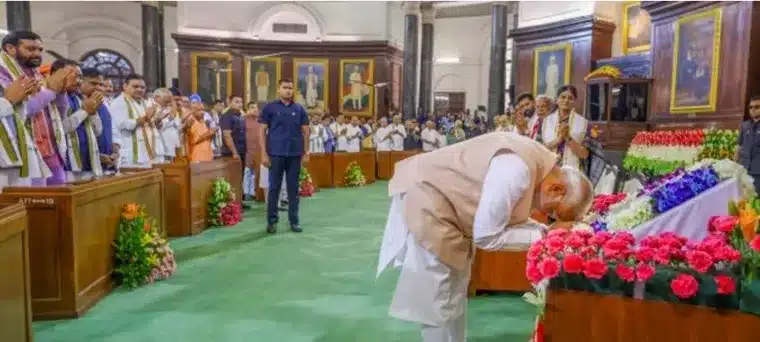What’s in today’s article?
- Why in News?
- Parliament House Complex
- Central Hall in Indian Parliament
- Can Central Hall be used by political parties or coalitions for their private events?
Why in News?
In a meeting of the BJP-led National Democratic Alliance (NDA), PM Modi was unanimously elected as the coalition’s Parliamentary Party leader. The event took place at the Central Hall of the old Parliament building.
Parliament House Complex
- About
- The Parliament House Complex in the heart of New Delhi contains several buildings:
- the new Parliament House that was opened last year;
- the old Parliament House,
- the iconic circular building that has now been renamed as Constitution House; Parliament House Annexe; and
- the Parliament Library Building.
- The Parliament House Complex in the heart of New Delhi contains several buildings:
- Custodian of the Parliament House Complex
- The Speaker of Lok Sabha is the custodian of the Parliament House Complex.
Central Hall in Indian Parliament
- About
- Since it was established in 1927, the Central Hall has witnessed several historical events.
- It is a pivotal and historically significant part of the Indian Parliament House, serving as a symbol of India’s democratic legacy and governance.
- Historical background
- Central Hall was originally used as the library for the members of the legislature.
- In 1946, the Constituent Assembly needed a place to meet and discuss the Constitution of independent India.
- The Central Hall was updated with new benches and renamed the Constituent Assembly Hall. The Assembly met here for about three years, from 1946 to 1949.
- First Independence Day and the Central Hall
- On August 15, 1947, the Central Hall witnessed the transfer of power from British rule to independent India, with the first Prime Minister, Jawaharlal Nehru, delivering his famous “Tryst with Destiny” speech.
- Architectural Features
- Design: The Central Hall is an octagonal structure with a distinctive dome, emblematic of classical architectural styles.
- Seating: It is designed to accommodate joint sessions of the two houses of Parliament—the Lok Sabha (House of the People) and the Rajya Sabha (Council of States).
- Decor: The Hall is adorned with portraits of prominent leaders of the Indian freedom movement and former Presidents and Prime Ministers of India.
- Functions and Usage
- Joint Sessions: The Central Hall is used for joint sittings of both houses of Parliament, particularly during significant addresses such as the President’s speech at the commencement of the budget session.
- Meetings: It serves as a venue for informal discussions and meetings among members of Parliament.
- Ceremonial Occasions: The Hall is also used for important ceremonial occasions, including the swearing-in of Presidents and Prime Ministers.
- Addresses by Heads of State of other countries: Central Hall was used for addresses by Heads of State of other countries.
- The last address was by Inter-Parliamentary Union (IPU) President Duarte Pacheco in March 2021 and before him, it was then United States President Barack Obama in November 2010.
- Current status of the old Parliament House where Central Hall is located
- The chambers of the old Parliament House are currently not being used for holding Sessions.
- Lok Sabha and Rajya Sabha meet in the new building. However, the Parliament Secretariat has some offices that continue to operate out of the old building.
Can Central Hall be used by political parties or coalitions for their private events?
- The Speaker of Lok Sabha is the custodian of the Parliament House Complex.
- Political parties and groups are allocated office space inside the complex.
- They can hold meetings with their members on the premises.
- In the past, political parties have held their Parliamentary Party meetings at venues within the complex, including at the Balayogi Auditorium in the Parliament Library Building.
- In May 2014, soon after the announcement of that year’s Lok Sabha election results, Modi was elected leader of the BJP Parliamentary Party at a meeting held in Central Hall.
Q.1. What is Inter-Parliamentary Union (IPU)?
The IPU is the international organization of Parliaments (Article 1 of the Statutes of the Inter-Parliamentary Union). It was established in 1889. The Union is the focal point for world-wide parliamentary dialogue and works for peace and co-operation among peoples and for the firm establishment of representative democracy..
Q.2. Who is the custodian of the Parliament House Complex?
The Speaker of Lok Sabha is the custodian of the Parliament House Complex.
Source: Central Hall: Where Modi addressed NDA, historic venue in Parliament
Last updated on December, 2025
→ Check out the latest UPSC Syllabus 2026 here.
→ Join Vajiram & Ravi’s Interview Guidance Programme for expert help to crack your final UPSC stage.
→ UPSC Mains Result 2025 is now out.
→ UPSC Notification 2026 is scheduled to be released on January 14, 2026.
→ UPSC Calendar 2026 is released on 15th May, 2025.
→ The UPSC Vacancy 2025 were released 1129, out of which 979 were for UPSC CSE and remaining 150 are for UPSC IFoS.
→ UPSC Prelims 2026 will be conducted on 24th May, 2026 & UPSC Mains 2026 will be conducted on 21st August 2026.
→ The UPSC Selection Process is of 3 stages-Prelims, Mains and Interview.
→ UPSC Result 2024 is released with latest UPSC Marksheet 2024. Check Now!
→ UPSC Prelims Result 2025 is out now for the CSE held on 25 May 2025.
→ UPSC Toppers List 2024 is released now. Shakti Dubey is UPSC AIR 1 2024 Topper.
→ UPSC Prelims Question Paper 2025 and Unofficial Prelims Answer Key 2025 are available now.
→ UPSC Mains Question Paper 2025 is out for Essay, GS 1, 2, 3 & GS 4.
→ UPSC Mains Indian Language Question Paper 2025 is now out.
→ UPSC Mains Optional Question Paper 2025 is now out.
→ Also check Best IAS Coaching in Delhi

















